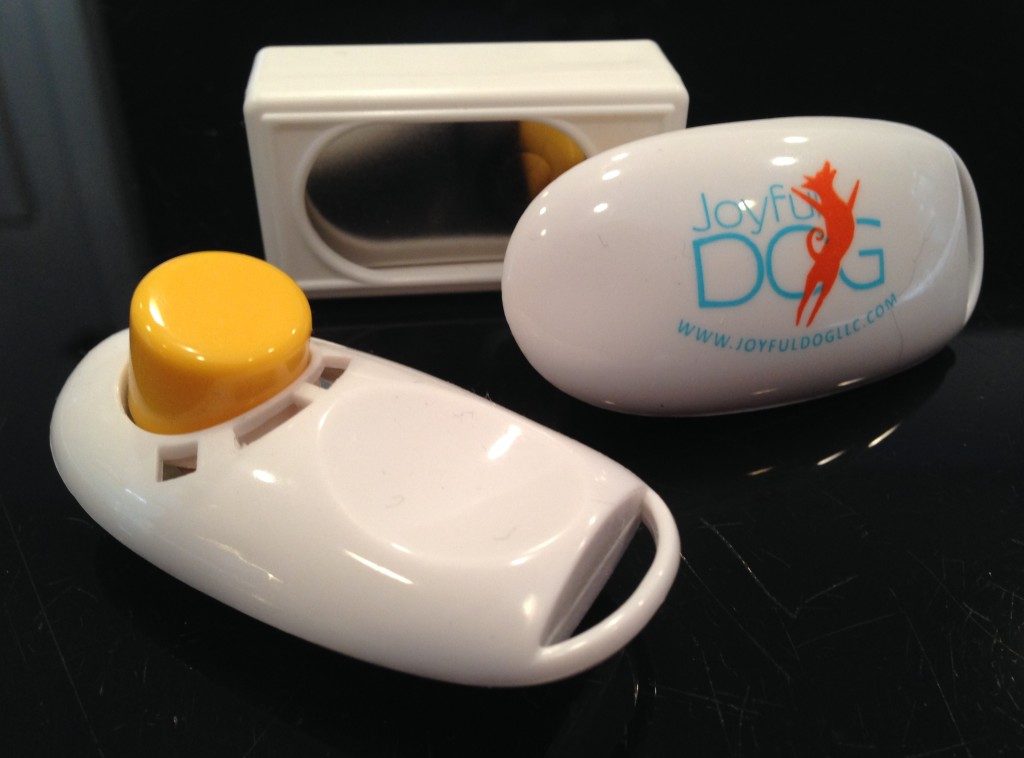Spend a few minutes every day working on the “touch” cue:
- Choose which hand will be your targeting hand and whether you will present your hand as an open hand, or with two or three fingers extended. Gather ten tiny treats and your clicker into the other hand.
- Keep hand/fingers very still and present them near and slightly to the side of the dog’s nose (about an inch).
- When dog is successful touching your hand or fingers about 80% percent of the time at this distance, add a verbal cue.
- Now present your hand from about 2 inches away. Continue to add distance, but ONLY when your dog is successful 80% of the time from each distance.
- Lather, rinse, repeat.
Variations
You can also try this with a wooden spoon, holding the spoon out for your dog to touch with his nose (again, very still, no movement of the spoon!). Click when you see/feel the dog hit the spoon with her nose. All of the same steps apply here with the spoon as with the hand: keep the spoon very still and start with it very close to your dog’s nose. Only add distance and change positions when your dog is doing it perfectly 80% of the time.
You’ve been doing this with either your left or right hand up until now; change hands when you’ve got some strong behavior with the first hand.
Troubleshooting
Many dogs are sensitive to our hands being near their faces or heads, so pay close attention to how your dog reacts when you place your hand or fingers in front of them. You might want to put your hand or fingers just to the side of your dog’s nose, and not immediately in front, especially if she is backing up.
As well, make sure that you are not moving your hand away from your dog as they attempt to touch it. Such a motion can become very aversive or frustrating for them, and defeats the whole purpose of doing fun stuff with your dog!
If you feel like your dog’s nose is not really hitting your hand nice and firmly, wait for them to give you a firm bump, then click and treat. All you are doing here is raising the criteria, from a ‘meh’ bump to one that is stronger.

Things to Bring
- Your Pup!
- Well-behaved children and spouses 8 or older.
- A flat collar, harness, or martingale collar.
- Lots of pea-sized soft treats in at least two different flavors. 200 tiny pieces are not too many. Some suggestions: Hot dogs, String cheese, Meatballs, Chicken or Tuna, Baby food (in a camping tube), Vienna sausages, Liverwurst, Thin-sliced Beef.
- A fanny pack, carpenter’s apron, or treat pouch to hold your 200 tiny pieces.
- A 6-foot leash.
- A mat, bathmat, towel, or blanket for your puppy or dog to rest on.
- Water and a bowl for when your pup gets thirsty.
Do's and Don'ts
- Do let us know if your pup has any food allergies so that we can be careful not to give him a troublesome treat.
- Don’t bring prong, choke, shock, or citronella collars.
- Don’t bring Flexi or other retractable leashes.
- Puppies and dogs should not meet while on leash in class, or while coming and going. There will be opportunities for off-leash play for compatible puppies, and good neighbor exercises for older pups and dogs.
- Don’t feed a heavy meal before coming to class. In fact, your in-class treats can serve as your dog’s breakfast on class day!
- If your puppy or dog is ill, please leave him at home to recuperate, but feel free to come to class without him so that you can learn what’s on the agenda for that day.

